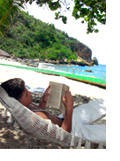
Change is on its way
Based on the worldwide success and recognition of Cuban medicine's tangible outcomes, the competitiveness and sensitivity of its human resources, Cuba's treatments and therapeutics have been getting a stronger toehold and spreading rapidly in a number of countries as more and more patients turn to the alternatives the island nation has to offer.
Fore over 15 years, an addiction rehab program has been successfully in place, based on the experience of Cuba's psychiatry and psychology experts who have made the most of the development countries like Italy, Spain, Argentina, Colombia and the U.S. have had on this particular matter. Its work scheme hinges on the so-called "therapeutic community" since it's through group therapy in which patients share their moods, feelings, states of minds and personal situations. It's all about redirecting the system of individual, familiar and social responsibilities in a piecemeal fashion in an effort to achieve two main goals: abstinence and a lifestyle change.
In this scenario, Cuba is blessed with the status of a drug-free country that leads the nation to implement a treatment that, unlike other variants applied in other parts of the world, is not based on the use of substituting drugs like methadone, nalthexone or LAAM (levo-alpha-acetylmethadol), whose application certainly soothes acute abstinence symptoms, de-intoxicates patients by keeping them away from doing drugs and therefore helps patients to get over the initial habit-kicking stages, yet in the long run it generates counterproductive side effects since it creates equally harmful addictions. On the other hand, there are centers that even admit patients unwilling to enter treatment but whose relatives, as well as social or legal pressures, have pushed them to do so.
The Cuban treatment is conducted in four different stages and is laid out to cover four areas: therapeutics, educational and occupational alternatives, self-governing, and tourism and health. The first stage stresses on individual and group therapy based on such techniques as pictography, movie debates, musical therapy and psychodrama, without downplaying the value of a sustained efforts with the family in a bid to establish positive patterns of interpersonal relationships, adequate orientation of the disease, rehabilitation and the patient's comeback to the social environment.
Acupuncture, relaxation and physical recreation are key players in the development of new values and the modification of lifestyles.
The area of educational and cultural alternatives gives a chance to boost the individual's intellectual and working potentials, taking account of his or her daily life and those abilities that were hurt by the sustained use of drugs. It puts abilities and behavioral patterns to the test through work and knowledge as it leads patients to the start of a new working life in the future.
For its part, self-governing becomes a basic structural element in the dynamics of therapeutic community whereby a group of patients acquire key responsibilities. Together with the rehabilitation team, patients have a say in the decision-making process and control of internal functioning.
Finally, the tourism and health area proposes an approach to those cultural values (museums, theaters, movies) and natural values (parks, beaches, ecological trails, thermal enjoyment) within the environment that patients enjoy depending on their evolution and self-regulation ability acquired during the treatment process in the form of stimuli granted by the therapeutic community.

|

